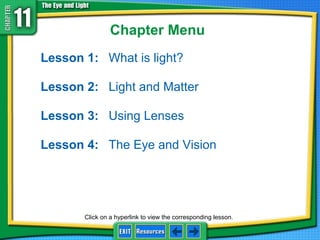The document provides an overview of key concepts related to light and vision. It includes lessons on what light is, how light interacts with matter, using lenses, and the anatomy and function of the human eye. Specifically, it defines key terms like wavelength, frequency, medium, electromagnetic spectrum. It describes how light can be absorbed, transmitted, scattered, and refracted when interacting with matter. It also explains lens concepts such as focal point, focal length, and how lenses are used in optical instruments like cameras, telescopes, and microscopes. Finally, it outlines the major parts of the eye including the cornea, iris, pupil, lens, and retina and how they work together to form images.












































































